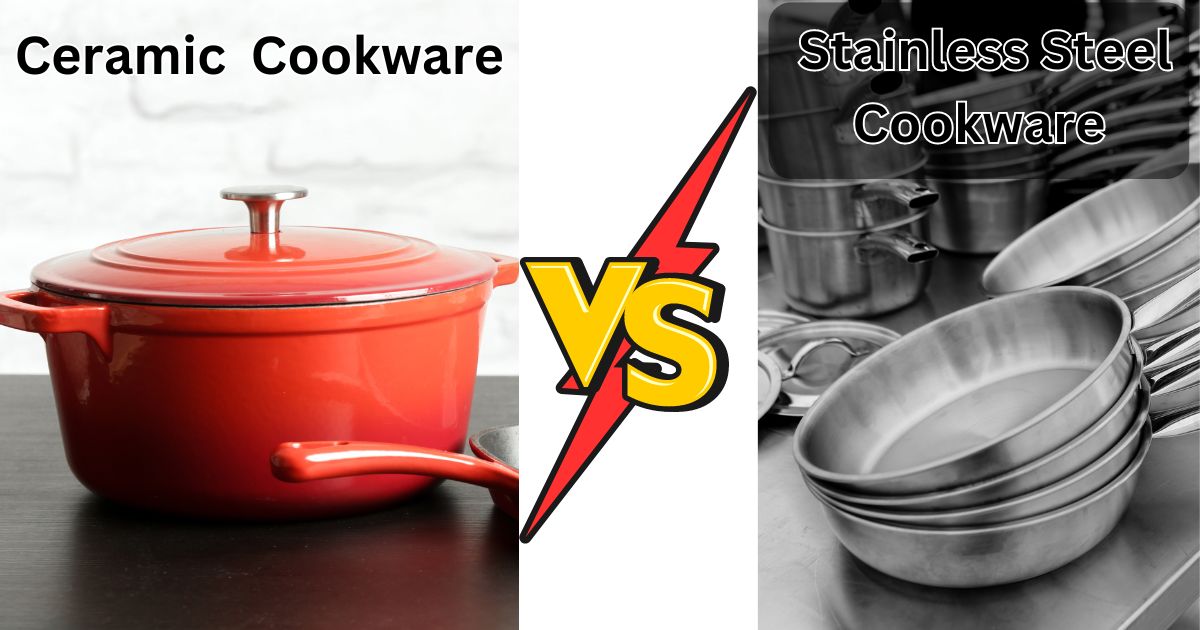When it comes to choosing the right cookware for your kitchen, two materials often stand out: ceramic and stainless steel. In the debate of Ceramic vs Stainless Steel Cookware, both options have their unique qualities and benefits, making them popular choices among home cooks and professional chefs alike. This article delves deep into the differences between Ceramic vs Stainless Steel Cookware, helping you make an informed decision based on your cooking needs.
Introduction to Cookware Materials
Cookware is an essential part of any kitchen, and the material it’s made from can significantly impact your cooking experience. Whether you’re a seasoned chef or a beginner, understanding the characteristics of different cookware materials is crucial. Ceramic and stainless steel are two of the most popular materials, each offering distinct advantages. The right cookware can make your cooking more enjoyable, efficient, and even healthier.
What is Ceramic Cookware?
Ceramic cookware is known for its non-stick surface and vibrant colors. It is made from natural clay that is baked and glazed, resulting in a smooth, non-reactive surface. There are two main types of ceramic cookware: 100% ceramic and ceramic-coated cookware. The former is made entirely of clay, while the latter typically consists of a metal base with a ceramic coating. This coating provides the non-stick properties that ceramic cookware is famous for.
Ceramic cookware is ideal for those who prefer a natural, eco-friendly option. The non-stick surface allows for cooking with less oil, making it a healthier choice. Additionally, ceramic cookware is free from harmful chemicals like PFOA and PTFE, commonly found in traditional non-stick pans.
Also Read: Mylt34
What is Stainless Steel Cookware?
Stainless steel cookware is revered for its durability and versatility. Made from an alloy of iron, chromium, and sometimes nickel, stainless steel is resistant to rust and corrosion. The material is known for its shiny, polished finish and is often used in professional kitchens. Stainless steel cookware comes in various grades, with 18/10 (18% chromium, 10% nickel) being one of the most common, known for its excellent corrosion resistance.
Stainless steel cookware is prized for its ability to withstand high heat and its compatibility with various cooking surfaces, including induction. It doesn’t react with acidic foods, ensuring that the flavors remain pure. While stainless steel lacks a non-stick surface, its durability and even heat distribution make it a favorite among chefs for tasks like searing and browning.
Ceramic vs Stainless Steel Cookware: Key Differences
The primary difference between ceramic and stainless steel cookware lies in their material composition. Ceramic cookware is derived from natural clay, while stainless steel is an alloy of metals. This difference in material results in distinct characteristics such as weight, heat distribution, and durability.
Ceramic cookware is generally lighter than stainless steel, making it easier to handle. However, stainless steel cookware tends to have better heat retention and distribution, which is crucial for achieving even cooking results. While ceramic cookware offers a non-stick surface, stainless steel requires more careful handling to prevent food from sticking.
Cooking Performance: Ceramic vs Stainless Steel
When it comes to cooking performance, both ceramic and stainless steel cookware have their strengths. Ceramic cookware excels in even heat distribution, making it perfect for delicate dishes that require gentle, consistent heat. The non-stick surface of ceramic pans is ideal for cooking eggs, pancakes, and other foods that tend to stick.
On the other hand, stainless steel cookware is preferred for high-heat cooking methods such as searing, browning, and deglazing. Its ability to withstand high temperatures without warping or damaging the surface makes it suitable for a wide range of cooking techniques. While stainless steel does not have a non-stick surface, proper preheating and oiling can help minimize sticking.
Durability and Longevity
Durability is a crucial factor when choosing cookware, and both ceramic and stainless steel have their merits. Ceramic cookware, especially 100% ceramic, is prone to chipping or cracking if not handled carefully. Ceramic-coated cookware, while more durable, can lose its non-stick properties over time as the coating wears off.
In contrast, stainless steel cookware is known for its exceptional durability. It can last a lifetime with proper care, and it is resistant to scratches, dents, and rust. Stainless steel’s longevity is one of its most significant advantages, making it a long-term investment for any kitchen.
Safety Concerns and Health Implications
Safety is a top priority in any kitchen, and understanding the health implications of your cookware is essential. Ceramic cookware is often marketed as a safer alternative to traditional non-stick pans because it is free from chemicals like PFOA and PTFE. However, it’s essential to note that not all ceramic cookware is created equal. The quality of the glaze and the manufacturing process can impact its safety.
Stainless steel cookware is generally considered safe for cooking, as it doesn’t react with acidic or alkaline foods. However, some people may have concerns about the leaching of metals, particularly nickel, into food. High-quality stainless steel, such as 18/10, minimizes this risk, making it a safe choice for most cooking tasks.
Ease of Cleaning and Maintenance
Cleaning and maintenance are vital aspects of cookware usability. Ceramic cookware is relatively easy to clean due to its non-stick surface. Food residue rarely sticks to the surface, and most ceramic pans can be cleaned with mild soap and water. However, abrasive cleaners and metal utensils should be avoided to prevent scratching the glaze.
Stainless steel cookware, while not non-stick, can be cleaned effectively with the right techniques. Stuck-on food can be removed by soaking the pan in warm, soapy water and using a non-abrasive scrubber. Stainless steel is dishwasher safe, but hand washing is recommended to maintain its shine and longevity. Regular polishing can help keep stainless steel cookware looking as good as new.
Aesthetic Appeal: Which Looks Better in Your Kitchen?
Aesthetic appeal is another consideration when choosing between ceramic and stainless steel cookware. Ceramic cookware is available in a wide range of colors and designs, allowing you to match it with your kitchen decor. Its vibrant appearance can add a touch of style to your kitchen, making it an attractive option for those who value aesthetics.
Stainless steel cookware, with its sleek, polished finish, offers a timeless and professional look. While it may not have the color variety of ceramic cookware, its shiny, mirror-like appearance can complement any kitchen style. Stainless steel’s classic look is favored by those who prefer a minimalist and modern kitchen design.
Cost Comparison: Ceramic vs Stainless Steel Cookware
Cost is often a determining factor when choosing cookware, and ceramic and stainless steel options vary widely in price. Ceramic cookware can range from affordable to high-end, depending on the quality and brand. 100% ceramic cookware tends to be more expensive than ceramic-coated options, but it may offer better performance and durability.
Stainless steel cookware, particularly high-quality sets, can be more expensive than ceramic cookware. However, its durability and versatility often justify the higher price. While the initial investment in stainless steel cookware may be higher, its longevity can make it more cost-effective in the long run.
Heat Tolerance and Oven Safety
Heat tolerance is a crucial factor in cookware performance, especially for those who cook at high temperatures. Ceramic cookware generally has a lower heat tolerance compared to stainless steel. Most ceramic cookware can withstand temperatures up to 450°F, making it suitable for stovetop cooking and moderate oven use.
Stainless steel cookware, on the other hand, has a much higher heat tolerance. It can withstand temperatures well over 500°F, making it ideal for searing, frying, and baking. Stainless steel is also broiler-safe, allowing you to use it for a broader range of cooking methods.
Compatibility with Cooking Surfaces
The compatibility of cookware with different cooking surfaces is another essential consideration. Ceramic cookware works well on gas and electric stoves but may not be suitable for induction cooktops unless it has a magnetic base. Additionally, ceramic cookware should be used with caution on glass stovetops, as its weight and potential for chipping can cause damage.
Stainless steel cookware is highly versatile and can be used on gas, electric, and induction cooktops. Its magnetic properties make it ideal for induction cooking, and its sturdy construction ensures it won’t damage glass stovetops. This compatibility makes stainless steel a more flexible choice for various cooking environments.
Environmental Impact of Ceramic vs Stainless Steel Cookware
The environmental impact of cookware is increasingly important for eco-conscious consumers. Ceramic cookware is often considered more environmentally friendly because it is made from natural materials and is free from harmful chemicals. Additionally, many ceramic cookware brands use sustainable manufacturing practices, further reducing their environmental footprint.
Stainless steel cookware is also an eco-friendly option, as it is durable, long-lasting, and recyclable. The production of stainless steel involves fewer harmful chemicals compared to non-stick coatings, and its long lifespan means it doesn’t need to be replaced as often. Both ceramic and stainless steel cookware have relatively low environmental impacts, making them responsible choices for the environmentally conscious consumer.
Popular Brands: Ceramic vs Stainless Steel Cookware
When choosing cookware, the brand can be a significant factor in quality and performance. Some of the top brands for ceramic cookware include GreenPan, Xtrema, and Caraway. These brands are known for their commitment to health-conscious, eco-friendly products that deliver excellent cooking performance.
For stainless steel cookware, brands like All-Clad, Cuisinart, and Calphalon are highly regarded. These companies offer a range of stainless steel cookware, from basic to professional-grade, ensuring that there’s an option for every budget and cooking need. Investing in a reputable brand can ensure you’re getting high-quality cookware that will last for years.
User Reviews and Satisfaction
User reviews are invaluable when assessing the performance and satisfaction levels of cookware. Ceramic cookware generally receives positive reviews for its non-stick properties, ease of cleaning, and aesthetic appeal. However, some users report that the non-stick coating can wear off over time, reducing its effectiveness.
Stainless steel cookware is often praised for its durability, heat distribution, and versatility. While some users find it challenging to clean, especially when food sticks, many appreciate its professional-level performance. Overall, user satisfaction for both ceramic and stainless steel cookware is high, but preferences often depend on individual cooking habits and needs.
Cooking Techniques: Best Uses for Ceramic Cookware
Ceramic cookware is particularly well-suited for low to medium-heat cooking. Its even heat distribution makes it ideal for cooking delicate foods like fish, eggs, and vegetables. The non-stick surface also allows for healthier cooking with less oil, making it a popular choice for those looking to reduce fat in their diet.
Ceramic cookware is also excellent for baking. Many ceramic pans and dishes can go from the stovetop to the oven, making them versatile for recipes that require both cooking methods. However, it’s essential to check the manufacturer’s instructions for oven safety, as some ceramic cookware may have temperature limitations.
Cooking Techniques: Best Uses for Stainless Steel Cookware
Stainless steel cookware excels in high-heat cooking techniques such as searing, sautéing, and deglazing. Its ability to withstand high temperatures without warping makes it perfect for achieving a golden-brown crust on meats and vegetables. Stainless steel pans are also ideal for making pan sauces, as the fond (browned bits) left behind can be easily deglazed to add depth of flavor.
Stainless steel is also a great choice for boiling, simmering, and steaming. Its excellent heat retention ensures that food cooks evenly, making it reliable for a wide range of dishes. While stainless steel may require more oil or butter to prevent sticking, its versatility and performance make it a staple in many kitchens.
Ceramic vs Stainless Steel Cookware: Pros and Cons
Both ceramic and stainless steel cookware have their advantages and disadvantages. Ceramic cookware’s primary benefits include its non-stick surface, ease of cleaning, and aesthetic appeal. However, its durability can be a concern, especially if the coating wears off or if it’s not handled carefully.
Stainless steel cookware is highly durable, versatile, and suitable for various cooking methods. Its main drawbacks are its lack of a non-stick surface and the potential for food to stick if not used correctly. However, with proper care and cooking techniques, stainless steel can offer exceptional performance and longevity.
Making the Right Choice: Ceramic vs Stainless Steel Cookware
Choosing between ceramic and stainless steel cookware ultimately depends on your cooking style, preferences, and budget. If you prioritize non-stick properties, easy cleaning, and aesthetic appeal, ceramic cookware might be the right choice for you. It’s especially suitable for those who cook at lower temperatures and prefer a healthier, oil-free cooking method.
On the other hand, if you value durability, versatility, and professional-level cooking performance, stainless steel cookware is likely the better option. It’s an excellent investment for those who frequently use high-heat cooking techniques and want cookware that will last a lifetime.
Conclusion
In the debate between ceramic vs stainless steel cookware, there’s no definitive winner—only the best choice for your needs. Ceramic cookware offers convenience and health benefits with its non-stick surface, making it ideal for everyday cooking. Stainless steel, with its durability and high-heat capabilities, is perfect for more advanced cooking techniques and long-term use.









